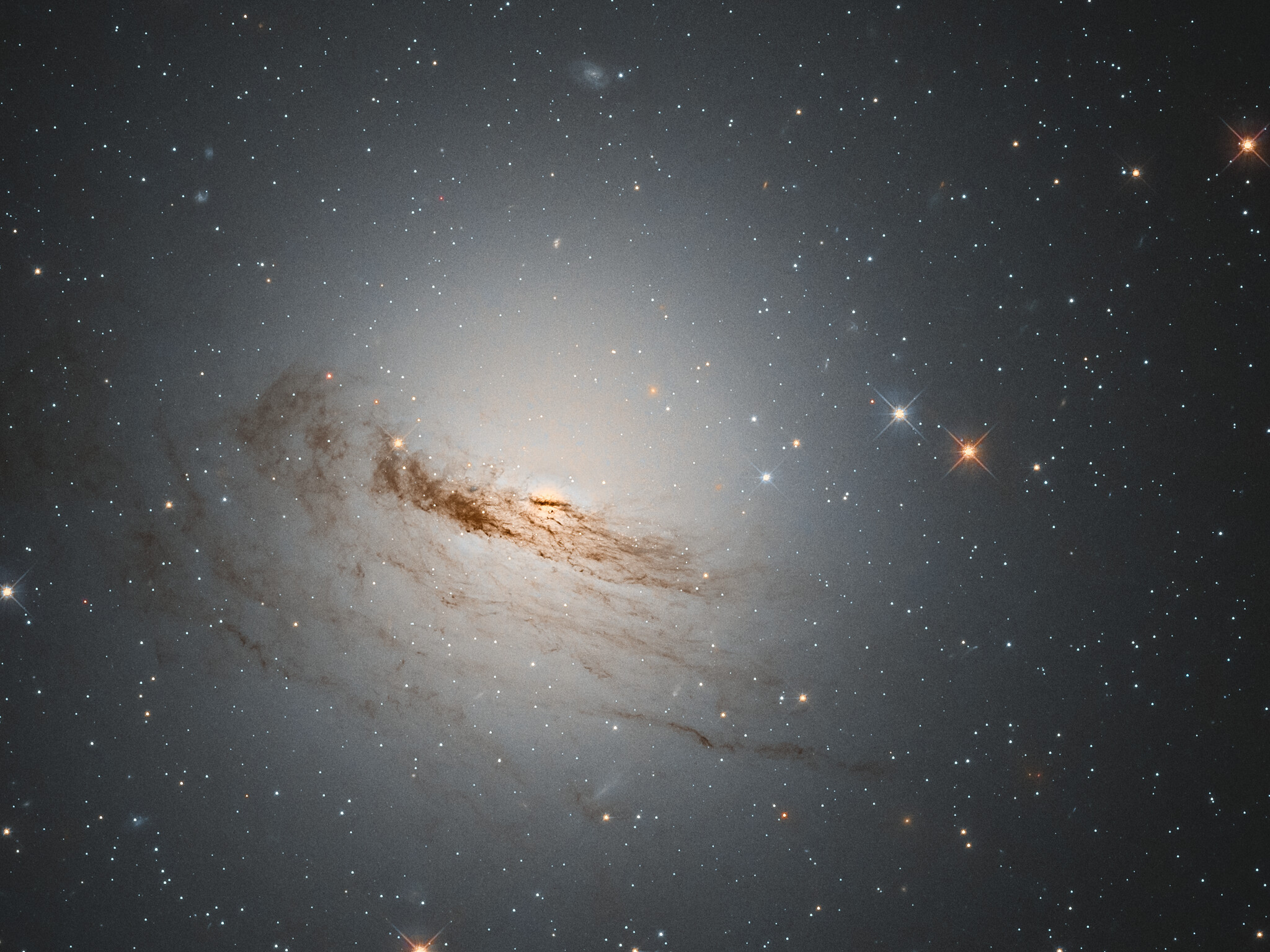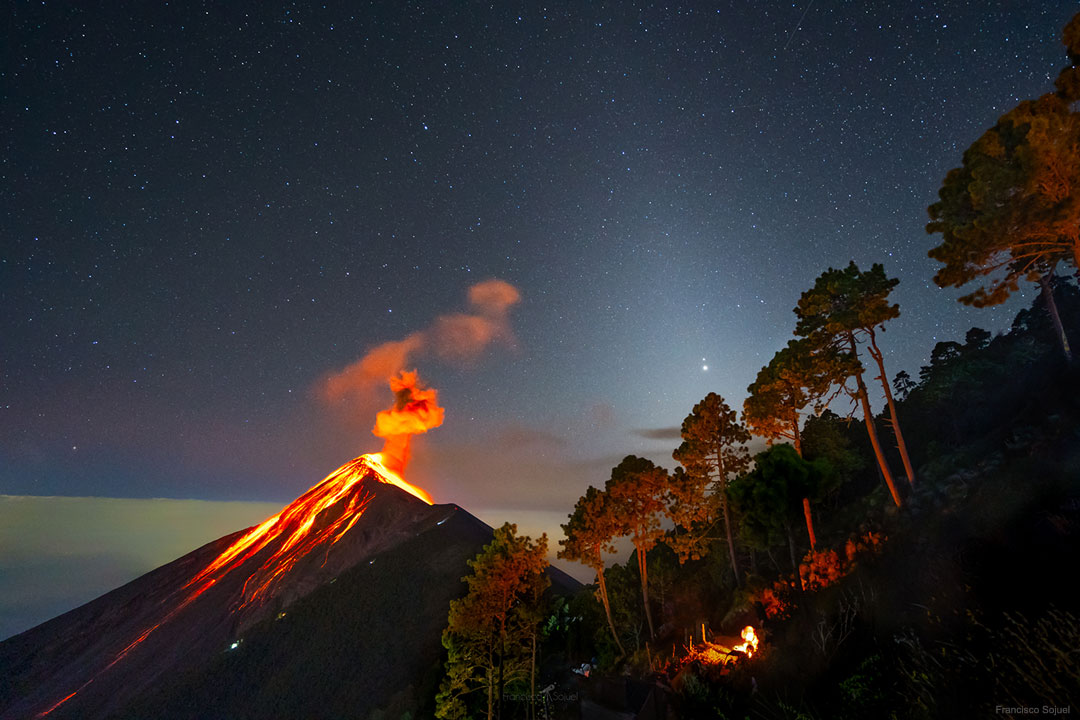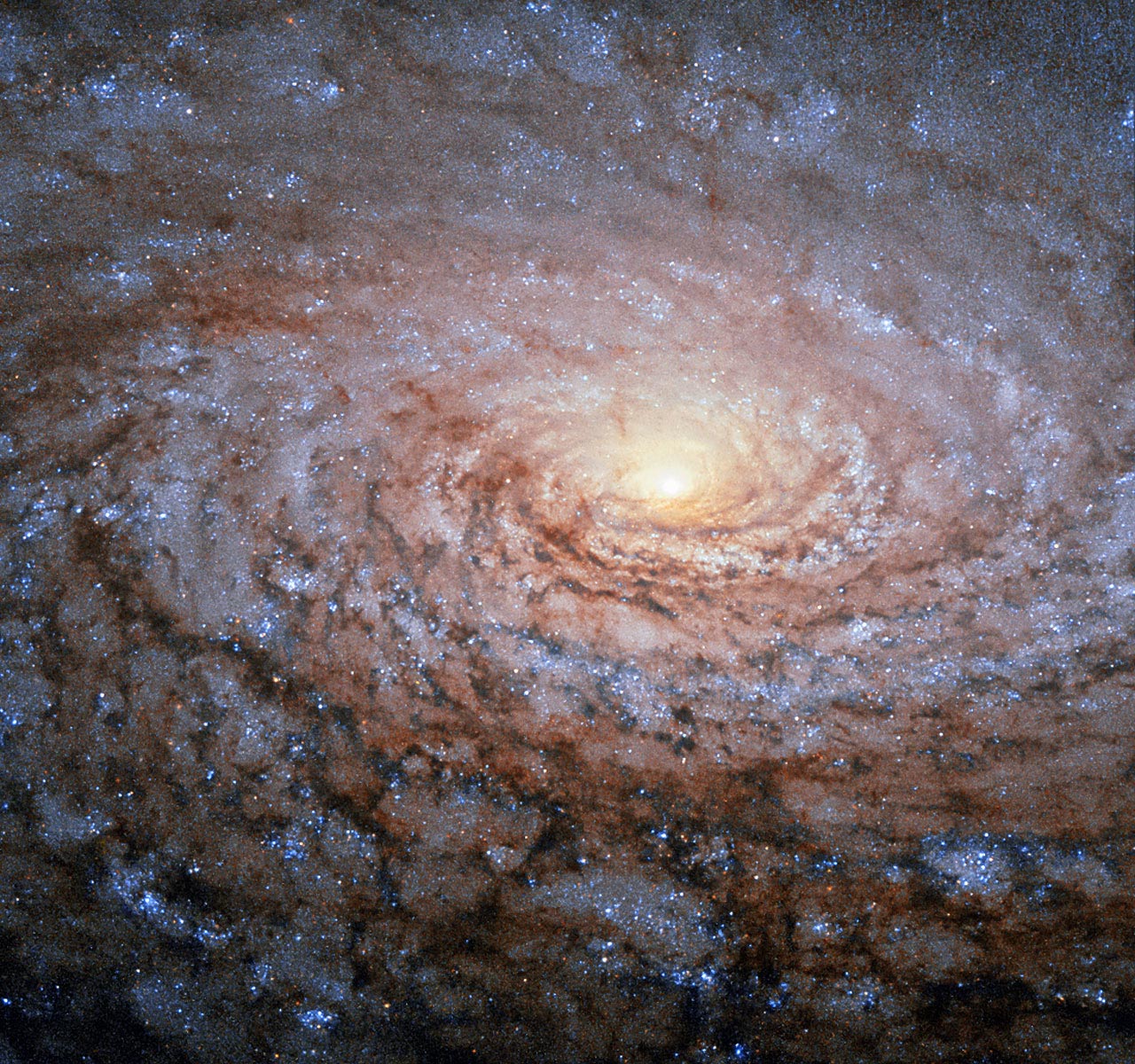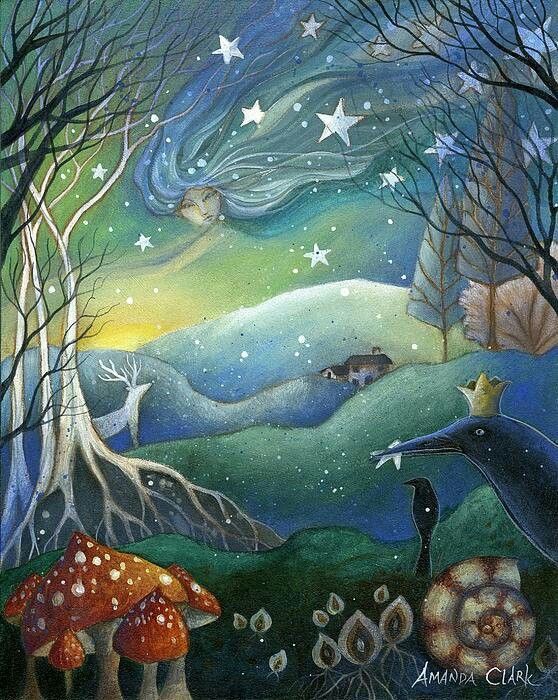This unusual lenticular galaxy, known as NGC 1947, has lost almost all the gas and dust from its signature spiral arms, which used to orbit around its centre. Discovered almost 200 years ago by James Dunlop, a Scottish-born astronomer who later studied the sky from Australia, NGC 1947 can only be seen from the southern hemisphere, in the constellation Dorado (The Dolphinfish). Residing around 40 million light-years away from Earth, this galaxy shows off its structure by backlighting its remaining faint gas and dust disc with millions of stars. In this picture, taken with the NASA/ESA Hubble Space Telescope, the faint remnants of the galaxy’s spiral arms can still be made out in the stretched thin threads of dark gas encircling it. Without most of its star-forming material, it is unlikely that many new stars will be born within NGC 1947, leaving this galaxy to continue fading with time.

Francisco Gustavo Sánchez Gómez (21 December 1947 – 25 February 2014), known as Paco de Lucía was a Spanish virtuoso flamenco guitarist, composer, and record producer. A leading proponent of the new flamenco style, he was one of the first flamenco guitarists to branch into classical and jazz. Richard Chapman and Eric Clapton, authors of Guitar: Music, History, Players, describe de Lucía as a “titanic figure in the world of flamenco guitar”, and Dennis Koster, author of Guitar Atlas, Flamenco, has referred to de Lucía as “one of history’s greatest guitarists”.
De Lucía was noted for his fast and fluent picados (fingerstyle runs). A master of contrast, he often juxtaposed picados and rasgueados(flamenco strumming) with more sensitive playing and was known for adding abstract chords and scale tones to his compositions with jazz influences. These innovations saw him play a key role in the development of traditional flamenco and the evolution of new flamenco and Latin jazz fusion from the 1970s. He received acclaim for his recordings with flamenco singer Camarón de la Isla in the 1970s, recording ten albums which are considered some of the most important and influential in flamenco history.
Some of de Lucía’s best known recordings include Río Ancho (later fused with Al Di Meola‘s Mediterranean Sundance), Entre dos aguas, La Barrosa, Ímpetu, Cepa Andaluza and Gloria al Niño Ricardo. His collaborations with guitarists John McLaughlin, Al Di Meola and Larry Coryell in the late 1970s saw him gain wider popularity outside his native Spain. De Lucía formed the Paco de Lucía Sextet in 1981 with his brothers, singer Pepe de Lucía and guitarist Ramón de Algeciras, and collaborated with jazz pianist Chick Corea on their 1990 album, Zyryab. In 1992, he performed live at Expo ’92 in Seville and a year later on the Plaza Mayor in Madrid. After 2004 he greatly reduced his public performances, retiring from full touring, and typically only gave several concerts a year, usually in Spain and Germany and at European festivals during the summer months.
see full post...ohn Josephus Hicks Jr. (December 21, 1941 – May 10, 2006 Atlanta, Ga) was an American jazz pianist, composer, and arranger. He was leader for more than 30 recordings and played as a sideman on more than 300.
After early experiences backing blues musicians, Hicks moved to New York in 1963. He was part of Art Blakey‘s band for two years, then backed vocalist Betty Carter from 1965 to 1967, before joining Woody Herman‘s big band, where he stayed until 1970. Following these largely mainstream jazz experiences, Hicks expanded into freer bands, including those of trumpeters Charles Tolliver and Lester Bowie. He rejoined Carter in 1975; the five-year stay brought him more attention and helped to launch his recording career as a leader. He continued to play and record extensively in the United States and internationally. Under his own leadership, his recordings were mostly bebop-influenced, while those for other leaders continued to be in a diversity of styles, including multi-year associations with saxophonists Arthur Blythe, David Murray, David “Fathead” Newman, and Pharoah Sanders.
https://www.youtube.com/watch?v=5e3FpF7T76o
see full post...Frank Vincent Zappa (December 21, 1940 – December 4, 1993 Baltimore, MD) was an American singer-songwriter, multi-instrumentalist, composer, and bandleader. His work is characterized by nonconformity, free-form improvisation, sound experiments, musical virtuosity, and satire of American culture. In a career spanning more than 30 years, Zappa composed rock, pop, jazz, jazz fusion, orchestral and musique concrète works, and produced almost all of the 60-plus albums that he released with his band the Mothers of Invention and as a solo artist. Zappa also directed feature-length films and music videos, and designed album covers. He is considered one of the most innovative and stylistically diverse rock musicians of his era.
As a self-taught composer and performer, Zappa’s diverse musical influences led him to create music that was sometimes difficult to categorize. While in his teens, he acquired a taste for 20th-century classical modernism, African-American rhythm and blues, and doo-wop music. He began writing classical music in high school, while at the same time playing drums in rhythm and blues bands, later switching to electric guitar. His 1966 debut album with the Mothers of Invention, Freak Out!, combined songs in conventional rock and roll format with collective improvisations and studio-generated sound collages. He continued this eclectic and experimental approach whether the fundamental format was rock, jazz, or classical.
Zappa’s output is unified by a conceptual continuity he termed “Project/Object”, with numerous musical phrases, ideas, and characters reappearing across his albums. His lyrics reflected his iconoclastic views of established social and political processes, structures and movements, often humorously so, and he has been described as the “godfather” of comedy rock. He was a strident critic of mainstream education and organized religion, and a forthright and passionate advocate for freedom of speech, self-education, political participation and the abolition of censorship. Unlike many other rock musicians of his generation, he disapproved of drugs but supported their decriminalization and regulation.
Zappa was a highly productive and prolific artist with a controversial critical standing; supporters of his music admired its compositional complexity, while critics found it lacking emotional depth. He had some commercial success, particularly in Europe, and worked as an independent artist for most of his career. He remains a major influence on musicians and composers. His honors include his 1995 induction into the Rock and Roll Hall of Fameand the 1997 Grammy Lifetime Achievement Award. In 2000, he was ranked number 36 on VH1‘s 100 Greatest Artists of Hard Rock. In 2004, Rolling Stone magazine ranked him at number 71 on its list of the “100 Greatest Artists of All Time”, and in 2011 at number 22 on its list of the “100 Greatest Guitarists of All Time”.
see full post...Bennie Ross “Hank” Crawford, Jr. (December 21, 1934 – January 29, 2009) was an American R&B, hard bop, jazz-funk, soul jazz alto saxophonist, arranger and songwriter. Crawford was musical director for Ray Charles before embarking on a solo career releasing many well-regarded albums on Atlantic, CTI and Milestone.
Crawford was born in Memphis, Tennessee. He began formal piano studies at the age of nine and was soon playing for his church choir. His father had brought an alto saxophone home from the service and when Hank entered Manassas High School, he took it up in order to join the band. He credits Charlie Parker, Louis Jordan, Earl Bostic and Johnny Hodges as early influences.
Crawford appears on an early 1952 Memphis recording for B.B. King with a band including Ben Branch and Ike Turner.
In 1958, Crawford went to college at Tennessee State University in Nashville, Tennessee. While at TSU, he majored in music studying theory and composition, as well as playing alto and baritone saxophone in the Tennessee State Jazz Collegians. He also led his own rock ‘n’ roll quartet, “Little Hank and the Rhythm Kings”. His bandmates all thought he looked and sounded just like Hank O’Day, a legendary local saxophonist, which earned him the nickname “Hank”. This is when Crawford met Ray Charles, who hired Crawford originally as a baritone saxophonist. Crawford switched to alto in 1959 and remained with Charles’ band—becoming its musical director until 1963.
see full post...Where can I see the Great Conjunction? Near where the Sun just set. Directionally, this close passing of Jupiter and Saturn will be toward the southwest. Since the planetary pair, the Sun, and the Earth are nearly in a geometric straight line, the planets will be seen to set just where the Sun had set — from every location on Earth. When can I see the Great Conjunction? Just after sunset. Since the two planets are so near the Sun directionally, they always appear in the sky near the Sun, but can best be seen when the Earth blocks the Sun but not the planets: sunset. Soon thereafter, Jupiter and Saturn will also set, so don’t be late! Is tomorrow night the only night that I can see the Great Conjunction? Tomorrow night the jovian giants will appear the closest, but on any night over the next few days they will appear unusually close. Technically, the closest pass happens on 21 December at 18:20 UTC. Will there be an erupting volcano on the horizon near the Great Conjunction? Yes, for example if you live in Guatemala where the featured image was taken. Otherwise, generally, no. In the featured image captured last week, Jupiter and Saturn are visible toward the right, just above a tree, and bathed in the diffuse glow of zodiacal light.

see full post...
Stephen William “Billy” Bragg (born 20 December 1957) is an English singer-songwriter and left-wing activist. His music blends elements of folk music, punk rock and protest songs, with lyrics that mostly span political or romantic themes. His music is heavily centred on bringing about change and involving the younger generation in activist causes.
In 1977 Bragg formed the punk rock/pub rock band Riff Raff with Wiggy. The band decamped to rural Oundle in Northamptonshire in 1978 to record a series of singles (the first on independent Chiswick Records) which did not receive wide exposure. After a period of gigging in Northamptonshire and London, they returned to Barking and split in 1980. Taking a series of odd jobs including working at Guy Norris’ record shop in Barking high street. Bragg became disillusioned with his stalled music career and in May 1981 joined the British Army as a recruit destined for the Queen’s Royal Irish Hussars of the Royal Armoured Corps. After completing three months’ basic training, he bought himself out for £175 and returned home.
Bragg peroxided his hair to mark a new phase in his life and began performing frequent concerts and busking around London, playing solo with an electric guitar under the name Spy vs Spy (after the strip in Mad magazine).
see full post...
Lawrence Elliott Willis (December 20, 1942 – September 29, 2019) was an American jazz pianist and composer. He performed in a wide range of styles, including jazz fusion, Afro-Cuban jazz, bebop, and avant-garde.
Willis was born in New York City. After his first year studying music theory at the Manhattan School of Music he began performing regularly with Jackie McLean. After he graduated he made his first jazz recording, McLean’s Right Now! in January 1965, which featured two of Willis’ compositions. His first recording of any type, however, was as a singer with the Music and Arts Chorale Ensemble, performing an opera by Aaron Copland under the direction of Leonard Bernstein. He decided to concentrate on jazz because of the difficulties African-American musicians had in finding work in concert music.
Throughout his career he performed with a wide range of musicians, including several years as keyboardist for Blood, Sweat & Tears (beginning in 1972). He spent several years as pianist for trumpeters Nat Adderley and Woody Shaw as well as long and productive tenures with Roy Hargrove and with Jerry Gonzalez and his Fort Apache Band. His late recording with Paul Murphy, Exposé, demonstrated the fusion principles of bebop and avant-garde jazz. His composition “Sanctuary” began exploring works employing strings. After a successful performance in Frank Lloyd Wright‘s Annie Pfieffer Chapel at Florida Southern College‘s Child of the Sun Jazz Festival he was commissioned to write a full-scale orchestral work for jazz trio and orchestra. He worked with Hugh Masekela on a South African Suite of music and interpreted Miles Davis‘ work. He was in the Round About Midnight tour of Miles Davis’ music. He received the Don Redman award in 2011, and the Benny Golson Jazz Master Award at Howard University in 2012.
see full post...Pleasant Joseph known as Cousin Joe (December 20, 1907 — October 2, 1989) was a New Orleans blues and jazz singer, famous for his 1940s recordings with Sidney Bechet and Mezz Mezzrow. He was born in Wallace, Louisiana, United States and worked at Whitney Plantation throughout his childhood. Until 1945 Cousin Joe toured Louisiana; that year he was asked to take part in the King Jazz recording sessions organized by Mezzrow and Bechet. In the 1970s, Cousin Joe toured extensively throughout the UK and Europe, both individually and as part of the American Blues Legends ’74 revue organised by Big Bear Music. He also recorded the album Gospel-Wailing, Jazz-Playing, Rock’n’Rolling, Soul-Shouting, Tap-Dancing Bluesman From New Orleans for Big Bear.
see full post...the Sunflower galaxy (Messier 63 / NGC 5055) with the strongest external field among SPARC galaxies, whose well-measured rotation curve shows a mildly declining behavior at large radial distance and can be accurately modeled only with an external field effect.

